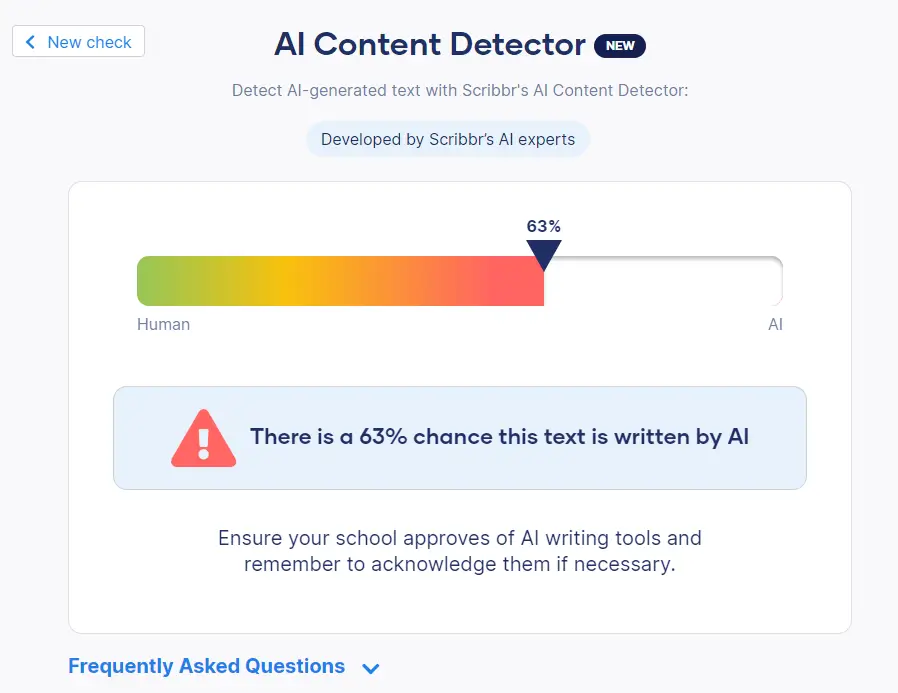AI Detector: Your First Line of Defense Against AI-Generated Materials
Recognizing the Value of an Ai Detector in Today's Digital Landscape
As man-made knowledge continues to permeate different facets of web content creation, identifying in between machine-generated and human-generated material has become progressively complex. These instruments not only aid in identifying AI-produced content however also promote the integrity of info dissemination.
The Rise of AI Web Content

The increase of AI-generated web content has significant ramifications for numerous markets, consisting of advertising and marketing, journalism, and amusement - ai detector. Organizations are significantly using these innovations to improve performance, customize web content, and involve target markets better. The capability to analyze large datasets enables AI systems to customize material to meet specific customer choices, providing a much more individualized experience
However, the proliferation of AI material likewise elevates vital considerations for web content designers and customers alike. As AI comes to be extra integrated into content production process, comprehending the subtleties of AI-generated product is essential for preserving quality and relevance in a rapidly advancing electronic environment. Embracing this technical advancement while remaining attentive concerning its ramifications is crucial for stakeholders in the digital media landscape.
Obstacles of Credibility
The appearance of AI-generated material has presented considerable obstacles relating to authenticity in electronic media. As algorithms become extra advanced, distinguishing between machine-generated and human-created web content becomes progressively tough. This obscuring of lines increases issues regarding the reliability of information and the potential for misinformation to multiply.
Among the primary obstacles is the erosion of trust among customers. With AI with the ability of producing reasonable message, images, and videos, people might locate it testing to discern genuine resources from deceptive ones. This hesitation can lead to a broader mistrust of all digital material, making complex initiatives to identify reputable details.
In addition, the implications for intellectual residential property are considerable. As AI tools create web content based upon existing works, questions concerning possession and originality occur. Web content creators might struggle to shield their work from uncredited AI recreations, weakening their resources and legal rights.
Last but not least, the capacity for destructive usages of AI-generated content, such as deepfakes and automatic propaganda, presents significant honest and social threats. These difficulties emphasize the urgent requirement for structures that promote credibility in the digital landscape, making certain that details continues to be reliable and trusted.
Duty of AI Detectors
Attending to the obstacles of authenticity in digital media requires ingenious solutions, and AI detectors have actually become a vital tool in this effort. These modern technologies are created to examine and recognize content created by expert system, consequently facilitating the discernment in between human-created and machine-generated products. The function of AI detectors expands beyond simple recognition; they likewise contribute to preserving the integrity of information consumed by the public.
AI detectors make use of innovative formulas to look at various elements of electronic web content, consisting of etymological patterns, architectural anomalies, and certain markers that suggest automation. Their application spans numerous sectors, consisting of journalism, education, and social networks, where the visibility of AI-generated material can lead to false information and disintegration of depend on.

Benefits of Using AI Detectors
Making certain credibility in electronic material symbolizes the basic requirement for count on information resources, and AI detectors serve as an effective ally in this pursuit. By determining AI-generated content, these tools aid maintain the honesty of details, thus shielding users from misinformation and boosting total content high quality.
One of the main advantages of making use of AI detectors is their ability to improve content confirmation procedures, significantly minimizing the moment and effort needed to analyze the credibility of electronic materials. This efficiency allows content creators, educators, and companies to concentrate on producing reputable and top notch info, rather than spending too much sources on fact-checking.
Furthermore, AI detectors foster accountability amongst content designers. The expertise that AI-generated material can be identified encourages transparency and moral practices in web content production. This, consequently, adds to a more educated digital area, as users can confidently involve with confirmed info.
Future of Web Content Verification
As the landscape of electronic web content remains to advance, the future of web content verification challenges both presents and possibilities for maintaining authenticity. As AI innovations development, so as well do the techniques for developing and distributing false information (ai detector). This arms race in between content designers and verification tools requires the growth of much more sophisticated AI detectors capable of critical real material from adjusted or made product
Additionally, the rise of decentralized innovations, such as blockchain, holds promise for verifying content provenance, making certain that customers can trace the origins of the information they eat. Inevitably, the future of content confirmation will hinge on our capacity to introduce when faced with evolving blog dangers, cultivating an electronic setting where credibility is recognized and promoted as a fundamental principle.
Conclusion
In conclusion, the proliferation of AI-generated content requires robust systems for credibility confirmation. The future of content verification pivots on the performance of AI detectors in keeping reputation throughout various media systems.
AI content development tools, such as natural language processing designs and generative adversarial networks, enable people and businesses to generate high-grade content at unprecedented speeds and reduced costs.
Nevertheless, the spreading of AI web content likewise elevates essential factors to consider for web content designers and consumers alike. As the sophistication of AI-generated web content continues to advance, the role of AI detectors ends up being progressively important in guarding authenticity and promoting transparency in digital interaction. The understanding that AI-generated material can be recognized encourages openness and ethical techniques in content production.As the landscape of electronic content continues to advance, the future of material verification provides both challenges and chances for preserving authenticity.